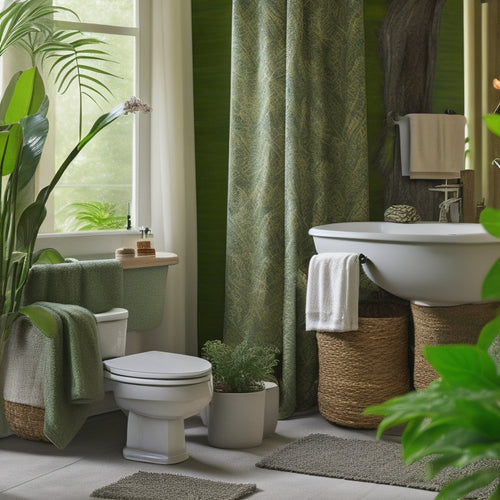
Why Natural Pest Control Boosts Vertical Garden Success
Share
By adopting natural pest control methods, you'll not only reduce your reliance on synthetic pesticides but also create a thriving, self-sustaining ecosystem that nurtures healthy plant growth, encourages beneficial insects, and promotes long-term sustainability in your vertical garden. Natural pest control enhances vertical garden success by encouraging microbe diversity, nutrient cycling, and ecosystem balance. You'll also attract helpful pollinators, support natural predators, and create a resilient environment that minimizes pest invasions. As you investigate these methods, you'll uncover a wealth of techniques to enhance your garden's health and productivity.
Key Takeaways
- Natural pest control methods maintain ecosystem balance, promoting a thriving environment for plants to grow in vertical gardens.
- Chemical-free pest control alternatives like neem oil and diatomaceous earth effectively deter pests without harming beneficial insects.
- Organic pest deterrents, such as garlic and citrus peels, repel pests while fostering a healthy and diverse microbial community.
- Physical barriers, like fine-mesh netting and row covers, provide an additional layer of protection against pests in vertical gardens.
- By adopting natural pest control methods, vertical gardeners can reduce their reliance on chemical pesticides, creating a more sustainable and resilient garden ecosystem.
Chemical-Free Pest Control Methods
Many vertical gardeners opt for chemical-free pest control methods to maintain the health and integrity of their plants. You can investigate natural repellents, such as essential oils and plant extracts, to deter pests. Organic sprays, like garlic sprays and insecticidal soap, are also effective.
Homemade solutions, including fermented plant juices, can be just as potent. Diatomaceous earth, a natural powder, can dehydrate and kill pests. Neem oil, a natural insecticide, is another option.
Companion flowers, beneficial nematodes, and trap crops can also help control pest populations. Additionally, incorporating sustainable practices, such as renewable energy sources, can contribute to a healthier environment for your plants.
By using eco-friendly charging solutions, you can reduce your carbon footprint and create a more sustainable vertical garden. Barrier methods, like fine mesh or fine-netted bags, can physically prevent pests from reaching your plants.
Scent deterrents, such as certain herbs, can repel pests. By using these chemical-free methods, you can guarantee a healthy, thriving vertical garden.
Soil Health and Microorganisms
You'll want to focus on creating a microbe-rich soil structure that nurtures a balanced ecosystem, where nutrient-cycling organisms thrive.
These tiny workers break down organic matter, recycle nutrients, and ward off pathogens, ultimately promoting a healthy soil environment.
By achieving this harmony, you'll set the stage for a resilient vertical garden that's better equipped to resist pest issues.
Incorporating green hydrogen fuel cells principles in your garden's design can also lead to a more sustainable and eco-friendly environment, while reducing your reliance on fossil fuels.
Microbe-Rich Soil Structure
Your vertical garden's soil structure serves as an intricate network of tunnels and caverns, teeming with microbial life. This complex ecosystem is vital for plant growth and natural pest control.
By encouraging microbe diversity, you'll create a resilient soil environment that benefits your plants. Integrating renewable energy sources, such as solar energy, can also reduce your carbon footprint and enhance energy independence.
Additionally, regular maintenance, including cleaning, is essential for ideal energy production and efficiency. To achieve this, consider incorporating the following soil amendments into your vertical garden:
- Compost: Rich in organic matter, compost supports microbial growth and improves soil structure.
- Worm castings: These natural fertilizers are teeming with beneficial microbes, promoting a healthy soil ecosystem.
- Mycorrhizal fungi: These symbiotic fungi enhance plant-microbe interactions, increasing plant immunity and nutrient uptake.
- Beneficial bacteria: Inoculating your soil with beneficial bacteria like Bacillus and Pseudomonas can help suppress pests and diseases.
Nutrient-Cycling Organisms Matter
In vertical gardens, nutrient-cycling organisms are the unsung heroes, working tirelessly behind the scenes to break down organic matter and recycle essential nutrients.
You'll find these microorganisms thriving in microbe-rich soil structures, where they facilitate ecological interactions that enhance soil biodiversity. As you add organic amendments, these organisms convert them into nutrient-rich compounds, increasing nutrient availability for your plants.
This nutrient cycling process is a critical ecosystem service that supports plant health and promotes symbiotic relationships between microorganisms and plants. By nurturing these microbial communities, you'll create a self-sustaining system that requires fewer inputs, giving you more freedom to enjoy your thriving vertical garden.
Additionally, incorporating renewable energy sources, such as solar energy solutions, can further reduce your environmental footprint and promote a healthier planet.
Balanced Ecosystem Harmony
How do the complex interactions between soil health and microorganisms impact the delicate balance of your vertical garden's ecosystem? As you aim for ecosystem resilience, understanding these relationships is essential.
Soil health is directly tied to microorganism activity, which in turn affects nutrient availability, water retention, and aeration. This intricate web of relationships can either support or hinder your garden's success.
Furthermore, incorporating solar-powered solutions, such as solar charging kits, can reduce your carbon footprint and create a more sustainable gardening practice. Additionally, regular inspections and maintenance can help identify issues impacting energy production, much like monitoring soil health and microorganisms in your vertical garden.
To achieve balanced ecosystem harmony, consider the following:
- Microbe-rich soil: Promotes biodiversity enhancement and strengthens ecosystem resilience.
- Optimal pH levels: Allows microorganisms to thrive, ensuring nutrient availability and uptake.
- Adequate aeration: Supports microorganism activity, promoting healthy root development.
- Diverse microbial communities: Encourages ecosystem services, such as decomposition and nutrient cycling, to flourish.
Encouraging Beneficial Insects
You can enhance your vertical garden's natural pest control by encouraging beneficial insects, which play an essential role in maintaining ecosystem balance.
By attracting helpful pollinators like bees and butterflies, you'll promote a healthy garden ecosystem.
Additionally, you'll support natural predators that prey on pests, reducing the need for chemical pesticides.
Attract Helpful Pollinators
Pollinator-friendly plants in your vertical garden can become a magnet for beneficial insects, which won't only facilitate pollination but also prey on pests that might harm your crops.
By incorporating flowering plants that provide pollinator habitats, you'll attract helpful pollinators like bees, butterflies, and hoverflies. These beneficial insects won't only pollinate your plants but also serve as natural predators, controlling pest populations.
Here are some flowering plants that can attract helpful pollinators to your vertical garden:
- Sunflowers - Their large, bright yellow petals are a guide for pollinators.
- Zinnias - These colorful flowers come in a variety of shapes and sizes, attracting a range of pollinators.
- Marigolds - With their strong, pungent scent, marigolds repel pests and attract beneficial insects.
- Bee Balm - As its name suggests, bee balm is a favorite of bees and other pollinators.
Preserve Ecosystem Balance
By incorporating pollinator-friendly plants in your vertical garden, you've taken the first step towards creating a balanced ecosystem. This encourages beneficial insects, which in turn promotes ecosystem resilience by maintaining a delicate balance between species.
By doing so, you're supporting biodiversity promotion, allowing your garden to thrive naturally. Beneficial insects like bees, butterflies, and ladybugs play an essential role in controlling pest populations, reducing the need for chemical pesticides.
A balanced ecosystem also promotes healthy plant growth, increases crop yields, and guarantees a sustainable gardening practice. By preserving ecosystem balance, you're creating a self-sustaining environment that requires minimal human intervention, giving you the freedom to enjoy a thriving vertical garden.
Support Natural Predators
Encouraging beneficial insects to thrive in your vertical garden is essential for maintaining a balanced ecosystem, as they serve as natural predators to unwanted pests.
By providing suitable habitats for these predators, you're creating a self-sustaining system that reduces the need for chemical pesticides.
Here's how you can support natural predators:
-
Diversify plant selection: Incorporate plants that attract beneficial insects, such as bees, butterflies, and ladybugs.
-
Maintain predator habitats: Incorporate features like rock piles, log piles, or brush piles to provide shelter for beneficial insects.
-
Practice ecosystem education: Learn about the life cycles and habits of beneficial insects to better understand their needs.
- Avoid broad-spectrum pesticides: Refrain from using pesticides that can harm beneficial insects, allowing them to thrive and do their job.
Natural Barriers to Pests
How effectively do you employ physical barriers to deter pests from invading your vertical garden?
Natural barriers are an essential component of integrated pest management. By incorporating pest-resistant plants and maintaining good garden hygiene, you can reduce the likelihood of infestations.
Row covers, fine-mesh screens, and fine-netted bags can prevent pests like whiteflies and aphids from reaching your plants.
Additionally, fine-textured mulches and diatomaceous earth can deter pests like slugs and snails.
Companion Planting Strategies
You can utilize the power of companion planting to naturally repel pests in your vertical garden.
By strategically selecting herbs that repel specific pests, you'll create a defense system that's both effective and eco-friendly.
Planting Pest-Repelling Herbs
By incorporating pest-repelling herbs into your vertical garden, you can utilize the power of companion planting to naturally deter unwanted pests.
This approach allows you to create a balanced ecosystem, reducing the need for chemical pesticides and nurturing a healthy environment for your plants to thrive.
When selecting herbs for pest control, consider the following:
-
Basil: Repels aphids, mites, and flies, making it an excellent choice for tomato and pepper plants.
-
Mint: Deters pests like ants, spiders, and mosquitoes, and can be planted near cucumbers and carrots.
-
Chives: Repels aphids and other pests, making it a great companion for roses and apple trees.
- Dill: Attracts beneficial insects and repels aphids, spider mites, and other pests, making it ideal for planting near cucumbers and squash.
Deter Pests With Diversity
Incorporating pest-repelling herbs into your vertical garden is just one aspect of natural pest control.
To take it to the next level, you'll want to focus on creating plant diversity and habitat variety. By doing so, you'll create an environment that's less appealing to pests.
When you combine different plants with varying growth habits, textures, and scents, you'll make it harder for pests to locate their preferred host plants. This approach also encourages beneficial insects, which prey on pests, to visit your garden.
Repel Pests Naturally
As you plan your vertical garden, consider leveraging companion planting strategies to repel pests naturally. This approach employs natural repellents to deter pests, reducing the need for chemical pesticides.
By strategically placing certain plants alongside others, you can create a pest-deterrent system that promotes a healthy and thriving garden.
Some effective companion planting strategies include:
-
Basil and Tomatoes: Basil repels whiteflies and aphids that target tomatoes.
-
Marigolds and Carrots: Marigolds deter nematodes that can harm carrots.
-
Chives and Roses: Chives repel aphids and other pests that target roses.
- Radish and Cucumbers: Radish repels cucumber beetles and other pests.
Organic Pest Deterrents Work
With vertical gardens, you're likely to encounter pests that can quickly spread and destroy your crops. Fortunately, organic pest deterrents can provide effective solutions without harming the environment or your plants.
| Organic Pest Deterrent | Description |
|---|---|
| Garlic Solution | Repels aphids, spider mites, and other pests with its strong scent |
| Neem Oil | Inhibits pest growth and reproduction with its natural insecticidal properties |
| Diatomaceous Earth | Dehydrates and kills pests with its abrasive, powdery texture |
| Citrus Peels | Deters pests with their strong citrus scent, perfect for homemade remedies |
| Coffee Grounds | Repels ants and snails with its acidity and texture |
These natural repellents can be used as organic sprays, essential oils, or homemade remedies to protect your vertical garden from pests. By incorporating plant extracts and natural repellents into your pest control strategy, you can guarantee a healthy and thriving garden without sacrificing your values.
Reducing Water Attraction
Pest control in vertical gardens goes beyond just using organic deterrents.
You need to take into account the entire ecosystem, including water management. Pests are attracted to moisture, so it's crucial to minimize water attraction in your garden.
Here's how:
-
Use efficient irrigation systems: Avoid overwatering by implementing a drip irrigation system or soaker hose that delivers water directly to the roots.
-
Improve soil moisture retention: Add organic matter like compost or mulch to retain moisture in the soil, reducing the need for frequent watering.
-
Monitor soil moisture levels: Regularly check soil moisture to avoid overwatering, which can attract pests.
- Fix leaks and water damage: Verify your garden's water system is leak-free, and address any water damage promptly to prevent pest infestations.
Physical Barriers to Pests
Vulnerability creeps in when vertical gardens are left unprotected, making them an easy target for pests. You can prevent this by using physical barriers to keep pests out. These barriers can be made from various materials, each with its own benefits and drawbacks.
| Barrier Material | Effectiveness | Cost |
|---|---|---|
| Fine-mesh netting | High | Moderate |
| Row covers | Medium | Low |
| Copper tape | Low | High |
| Fine-screened row covers | High | High |
| Bird-repellent tape | Low | Low |
Netting solutions and other barrier materials can be used to cover individual plants or entire garden beds. By choosing the right material for your garden, you can create a physical barrier that keeps pests out, allowing your plants to thrive.
Crop Rotation Benefits
Beyond the physical barriers, another essential aspect of natural pest control in vertical gardens is crop rotation, which plays a significant role in disrupting the life cycle of pests.
By rotating your crops, you're making it difficult for pests to adapt and thrive. This technique also promotes a diverse and resilient ecosystem.
Here are some benefits of crop rotation in vertical gardens:
-
Breaks disease and pest cycles: Crop rotation interrupts the life cycle of pests and diseases, reducing the risk of infestation and infection.
-
Encourages crop variety: By rotating crops, you can grow a diverse range of plants, reducing dependence on a single crop variety.
-
Maximizes seasonal timing: Crop rotation allows you to plant crops at ideal times, ensuring they thrive in the right seasonal conditions.
- Enhances soil health: Rotating crops helps maintain soil fertility and structure, reducing the need for synthetic fertilizers and pesticides.
Monitoring for Early Detection
Your vertical garden's health relies on your ability to detect pest issues early, and monitoring is an essential step in natural pest control.
You'll want to regularly inspect your plants, looking for early warning signs like yellowing leaves, white powdery residue, or tiny eggs on the underside of leaves.
Familiarize yourself with pest identification techniques, such as examining the shape and color of insects, their life cycles, and the damage they cause. This knowledge will help you identify pests quickly and accurately.
Keep a journal to track your observations, noting any changes in your plants or the presence of pests.
Frequently Asked Questions
How Often Should I Release Beneficial Insects in My Vertical Garden?
You should release beneficial insects every 1-2 weeks, depending on the insect's lifespan and garden conditions, to maintain a consistent presence and ideal timing for effective pest control, adjusting the frequency as needed based on pest pressure and insect release effectiveness.
Are All Organic Pest Deterrents Safe for Pets and Children?
It's not a coincidence that you're thinking about pet and child safety; you're already a conscious gardener! Not all organic pest deterrents are safe, but essential oils and companion planting can be effective, pet-friendly alternatives when used correctly, giving you peace of mind.
Can I Use Natural Pest Control Methods in Indoor Gardens?
You can effectively use natural pest control methods in indoor gardens by incorporating natural repellents, like neem oil and diatomaceous earth, into your indoor gardening routine to create a pest-free environment without harming people or pets.
Do Vertical Gardens Require More Pest Control Than Traditional Gardens?
As you tend to your vertical oasis, you'll find it's a delicate balancing act: vertical gardens, like precarious houses of cards, are more susceptible to pest issues due to increased humidity and proximity of plants, requiring customized pest management strategies to address these unique vulnerabilities.
Can Natural Pest Control Methods Be Used in Combination With Chemical Controls?
You can combine natural pest control methods with chemical controls by implementing integrated pest management strategies, ensuring chemical compatibility to avoid counteracting effects, and carefully selecting products that won't harm beneficial organisms.
Related Posts
-

10 Best WiFi Outlets for Tracking Home Energy Usage
You can optimize your home's energy usage with the right WiFi outlets, which provide real-time monitoring and control...
-

Sustainable Scrubbing: Top Bathroom Solutions for Earth-Conscious Homes
You're taking an important step towards creating a more sustainable home by switching to eco-friendly bathroom cleani...
-

7 Solar-Safe Window Solutions for Earth-Conscious Homeowners
As an earth-conscious homeowner, you're likely keen to find solar-safe window solutions that align with your values. ...


